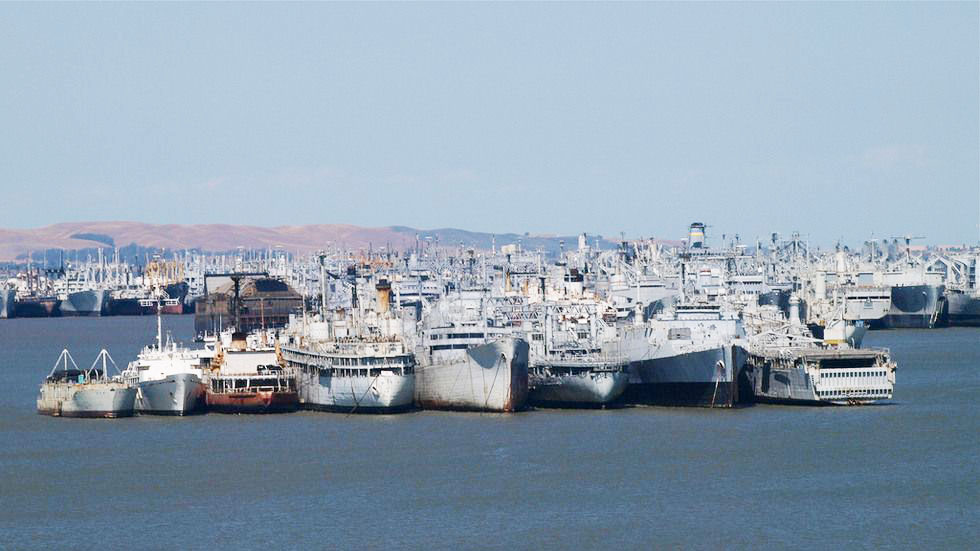In times of war governments tend to build a lot of warships, and once the conflicts are over they are left with a surplus of very expensive holes in the water.
Often a great deal is spent on preserving them because it seems a shame to toss them in the ashcan, but that’s where they end up.
The Suisun Fleet on the Sacramento River numbered as many as 350 ships after WWII. These were kept at the ready, and some did go to Korea, but most stayed put and slowly rotted at anchor. Today there are just eight left. 70 year old ships leak so the Navy has to maintain pumps which they deem to be cheaper than salvage because the ships are full of asbestos and covered in a ship load of lead paint. I’ve tried to get close but they have a patrol boat guarding them. I’ll bet that if you want one they will gladly hand it over. I’ve considered that little aircraft carrier for a dance party but the revelers would probably fall though the rusty deck.

Bottom left is the patrol boat that chased us off
The most interesting fleet to me is the Ghost Fleet of the Potomac. At the start of WWI we were losing 250 ships a month to German subs. A major push was undertaken to build ships out of steel, concrete and wood. 1,000 merchant ships about 350 feet long were ordered from a shipyard in Oregon where there was plenty of Douglas fir.

‘Help, we’re sinkingggg…”
The Navy was pretty pushy about delivery so the shipwrights were forced to use insufficiently dried wood. Over 300 were launched and they steamed through the Panama Canal to the east, leaking like crazy all the way. They never joined the fight because on arrival the war was canceled, so the ships were sold for scrap and ended up in Mallows Bay — 40 miles below DC on the Potomac. Ship breakers have been salvaging hulks there since the Civil War and 233 of these wooden ships (known as the White Elephant Fleet) ended up in the shallows. The salvers had hoped to sell the steam engines but the diesel engine came along, squashing that idea.

When the Elephants arrived, a boomtown sprung up with bootleggers, roughneck salvers, ladies of easy virtue and derelicts—both of the seaward kind and the human sort. Prohibition was the law of the land, but it was ignored at Mallows Bay.

Needs work, best offer
Eventually the wooden ships were burned to their water lines for the little scroungable metal and today you can still see the outlines of the hulks.

In the end just so much firewood
It’s stunning that we can afford to build billions of dollars’ worth of stuff that never gets used and then we bust our backs attempting to claw back a few bucks from the wreckage.
I think we should spend less on this nonsense and more on gigantic marionettes.








There was a group of “hobos” as they called themselves in the Oakland marina that used to sneak onto the mothball fleet and throw raves. They were hackers who lived on trains and boats and were really smart.
These people have their ship together
As always tanks for the memories
I can’t tell you how many times I’ve passed the Suisun Fleet ghost shipyard on road trips and someone always has something to say about it. Thanks to your article I’m now armed with a few facts next time I cruise by there. Which will actually be May heading to Shasta Lake! Missed it last year due to Covid. Keep on writing cause we’ll keep on reading!
How do we get those marionettes to the May Day Parade?!